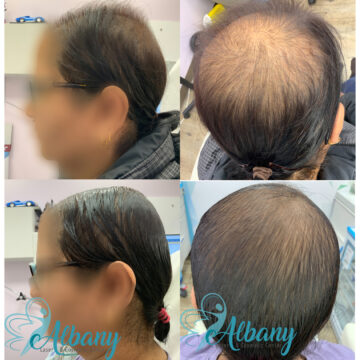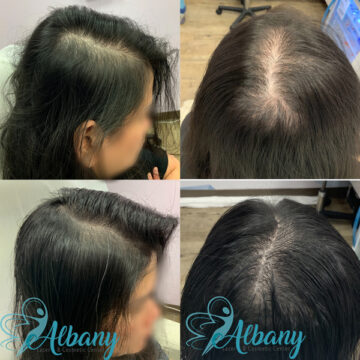PRP Hair Restoration Treatment in Edmonton
Hair thinning and loss can significantly impact self-confidence. At Albany Cosmetic and Laser Centre in Edmonton, we offer Platelet-Rich Plasma PRP Hair Restoration Treatment, a natural solution to combat hair loss. Utilizing your body’s own growth factors, PRP stimulates dormant hair follicles, promoting thicker and healthier hair growth.
Please visit our hair loss page for more information about other options
Understanding PRP Hair Restoration
PRP Hair Restoration procedure involves drawing a small amount of your blood, processing it to concentrate the platelets, and injecting this platelet-rich plasma into the scalp. These platelets release growth factors that rejuvenate hair follicles, enhance blood supply, and encourage new hair growth. PRP is particularly effective for individuals experiencing early-stage hair thinning or androgenetic alopecia.
Benefits of PRP Hair Restoration Treatment
- Natural Approach: Utilizes your own blood, reducing the risk of allergic reactions.
- Non-Surgical: Minimally invasive with no downtime.
- Effective Results: Improves hair density and thickness over time.
- Safe Procedure: Low risk of complications when performed by trained professionals.
Before and After PRP Hair Restoration


Our clients have experienced noticeable improvements in hair density and scalp coverage after undergoing PRP therapy. For instance, a 58-year-old female patient reported significant hair thickening following three PRP sessions spaced one month apart. These real-life transformations highlight the effectiveness of our treatments.
PRP Hair Restoration Procedure Summary
Treatment Cost
Procedure Duration
Recommended Sessions
Discomfort Level
Preparation and Aftercare for PRP Hair Treatment
Frequently Asked Questions
What is PRP hair restoration?
Is PRP therapy suitable for all types of hair loss?
PRP is most effective for individuals with early-stage hair thinning or androgenetic alopecia. A consultation will determine if PRP is right for you.
Are there any side effects?
Side effects are minimal and may include mild scalp tenderness or swelling, which typically subsides within a day or two.
How soon will I see results?
Most clients notice improvements in hair texture and thickness within 2–3 months, with continued progress over subsequent sessions.
Can PRP be combined with other treatments?
Yes, PRP can be combined with other therapies such as microneedling or laser treatments to enhance results.
How long do the results last?
Results can last up to 12 months, with maintenance sessions recommended to sustain hair growth.